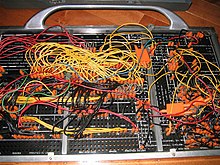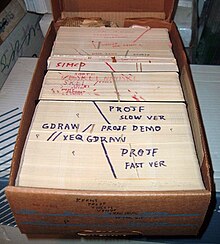Computer programming
The output from the process of computer programming (often shortened to programming or coding) is source code written in a programming language. This code may be a modification of existing source or something completely new. The process of writing source code requires expertise in many different subjects, including knowledge of the application domain and algorithms to implement the desired behavior.
Within software engineering, programming (the implementation) is regarded as one phase in a software development process.
There is an on going debate on the extent to which the writing of programs is an art or an engineering discipline.[1]
Another on going debate is the extent to which the programming language used in writing programs effects the form that the final program takes. This debate is analogous to that surrounding the Sapir Whorf hypothesis in linguistics.
Programming languages
Different programming languages support different styles of programming (called programming paradigms). The choice of language used may be an individual's choice or may be dictated by company policy. Ideally the programming language best suited for the task at hand will be selected. Trade-offs from this ideal involve finding enough programmers, who know the language, to build a team, the availability of compilers for that language, and the efficiency with which programs written in a given language execute.
History of programming

The earliest programmable machine (that is, a machine that can adjust its capabilities based upon changing its "program") can be said to be the Jacquard Loom, which was developed in 1801. The machine used a series of pasteboard cards with holes punched in them. The hole pattern represented the pattern that the loom had to follow in weaving cloth. The loom could produce entirely different weaves using different sets of cards. This innovation was later refined by Herman Hollerith of IBM in the development of the famous IBM punch card. These were used with a variety of machines called unit record equipment to perform data processing tasks. The unit record equipment were programmed by changing the wiring of plug-boards. Early computers used similar programming methods.

The invention of the Von Neumann architecture allowed programs to be stored in computer memory. Early programs had to be painstakingly crafted using the instructions of the particular machine, often in binary notation. Every model of computer would be likely to need different instructions to do the same task. Later assembly languages were developed that let the programmer specify each instruction in a text format, entering abbreviations for each operation code instead of a number and specifying addresses in symbolic form (e.g. ADD X, TOTAL). In 1954 Fortran, the first higher level programming language, was invented. This allowed programmers to specify calculations by entering a formula directly (e.g. Y = X*2 + 5*X + 9). The program text, or source, was converted into machine instructions using a special program called a compiler. Many other languages were developed, including ones for commercial programming, such as COBOL. Programs were mostly still entered using punch cards or paper tape. (See computer programming in the punch card era). In the mid-1970s, mass storage devices and computer terminals became inexpensive enough so programs could be created by typing directly into the computers. Text editors were developed that allowed changes and corrections to be made much more easily than with punch cards.
As time has progressed computers have made giant leaps in the area of processing power. This has brought about newer programing languages that are more abstracted from the underlying hardware. Although these more abstracted languages require additional overhead, in most cases the huge increase in speed of modern computers has brought about little performance decrease compared to earlier counterparts. The benefits of these more abstracted languages is that they allow both an easier learning curve for people less familiar with the older lower-level programming languages, and they also allow a more experienced programmer to develop simple applications quickly. Despite these benefits, large complicated programs, and programs that are more dependent on speed still require the faster and relatively lower-level languages with todays hardware. (The same concerns were raised about the original Fortran language.)
Throughout the second half of the twentieth century, programming was an attractive career in most developed countries. Some forms of programming have been increasingly subject to offshore outsourcing (importing software and services from other countries, usually at a lower wage), making programming career decisions in developed countries more complicated, while increasing economic opportunities in less developed areas. It is unclear how far this trend will continue and how deeply it will impact programmer wages and opportunities.
batty
Software development
Software is a mass noun for computer programs and data. The accompanying documentation and software license are also considered an essential part of the software, even though they don't involve any actual coding.
Creating software involves:
- Requirements analysis
- Specification
- Software architecture
- Coding
- Compilation
- Software testing
- Documentation
- Integration
- Maintenance
Notes
- ^ Paul Graham (2003). "Hackers and Painters". Retrieved 2006-08-22.
{{cite journal}}: Cite journal requires|journal=(help)
